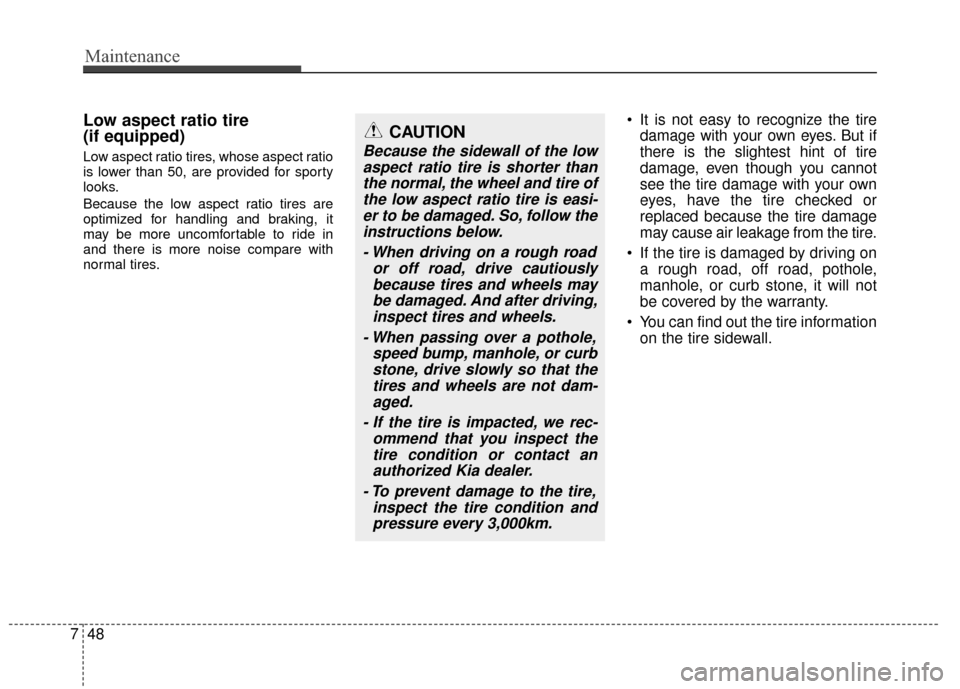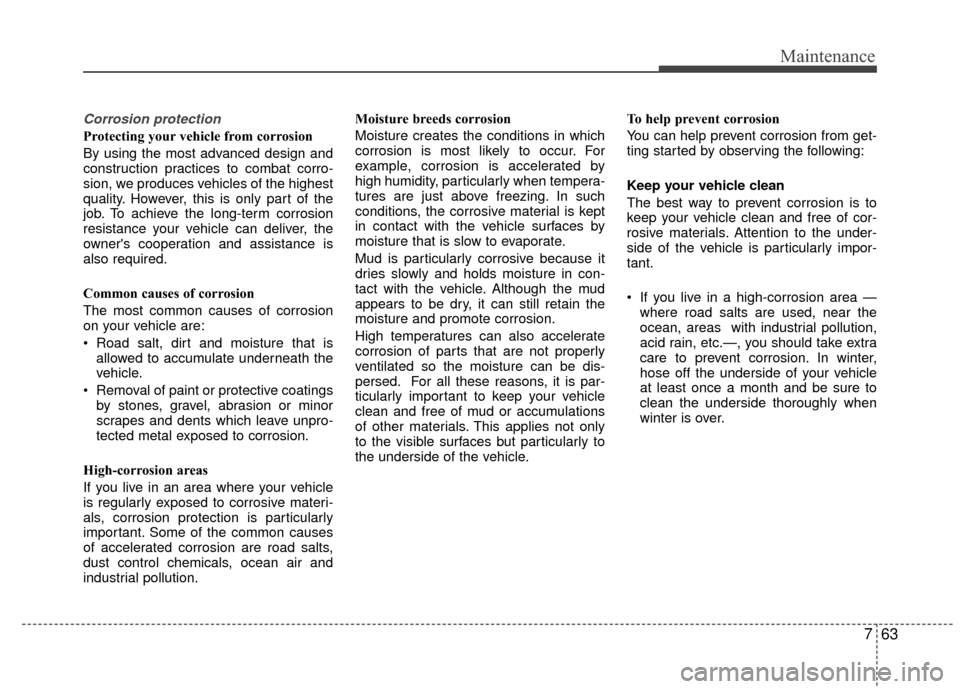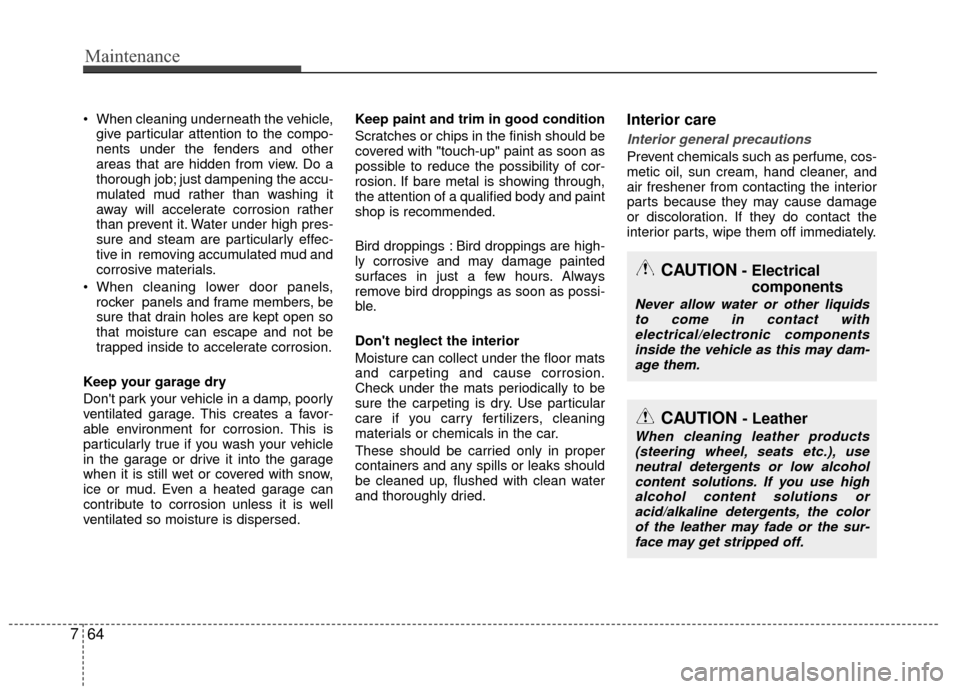2015 KIA Rio air condition
[x] Cancel search: air conditionPage 359 of 398

Maintenance
48
7
Low aspect ratio tire
(if equipped)
Low aspect ratio tires, whose aspect ratio
is lower than 50, are provided for sporty
looks.
Because the low aspect ratio tires are
optimized for handling and braking, it
may be more uncomfortable to ride in
and there is more noise compare with
normal tires.
It is not easy to recognize the tire
damage with your own eyes. But if
there is the slightest hint of tire
damage, even though you cannot
see the tire damage with your own
eyes, have the tire checked or
replaced because the tire damage
may cause air leakage from the tire.
If the tire is damaged by driving on a rough road, off road, pothole,
manhole, or curb stone, it will not
be covered by the warranty.
You can find out the tire information on the tire sidewall.CAUTION
Because the sidewall of the lowaspect ratio tire is shorter thanthe normal, the wheel and tire ofthe low aspect ratio tire is easi-er to be damaged. So, follow theinstructions below.
- When driving on a rough road or off road, drive cautiouslybecause tires and wheels maybe damaged. And after driving,inspect tires and wheels.
- When passing over a pothole, speed bump, manhole, or curbstone, drive slowly so that thetires and wheels are not dam-aged.
- If the tire is impacted, we rec- ommend that you inspect thetire condition or contact anauthorized Kia dealer.
- To prevent damage to the tire, inspect the tire condition andpressure every 3,000km.
Page 374 of 398

763
Maintenance
Corrosion protection
Protecting your vehicle from corrosion
By using the most advanced design and
construction practices to combat corro-
sion, we produces vehicles of the highest
quality. However, this is only part of the
job. To achieve the long-term corrosion
resistance your vehicle can deliver, the
owner's cooperation and assistance is
also required.
Common causes of corrosion
The most common causes of corrosion
on your vehicle are:
allowed to accumulate underneath the
vehicle.
Removal of paint or protective coatings by stones, gravel, abrasion or minor
scrapes and dents which leave unpro-
tected metal exposed to corrosion.
High-corrosion areas
If you live in an area where your vehicle
is regularly exposed to corrosive materi-
als, corrosion protection is particularly
important. Some of the common causes
of accelerated corrosion are road salts,
dust control chemicals, ocean air and
industrial pollution. Moisture breeds corrosion
Moisture creates the conditions in which
corrosion is most likely to occur. For
example, corrosion is accelerated by
high humidity, particularly when tempera-
tures are just above freezing. In such
conditions, the corrosive material is kept
in contact with the vehicle surfaces by
moisture that is slow to evaporate.
Mud is particularly corrosive because it
dries slowly and holds moisture in con-
tact with the vehicle. Although the mud
appears to be dry, it can still retain the
moisture and promote corrosion.
High temperatures can also accelerate
corrosion of parts that are not properly
ventilated so the moisture can be dis-
persed. For all these reasons, it is par-
ticularly important to keep your vehicle
clean and free of mud or accumulations
of other materials. This applies not only
to the visible surfaces but particularly to
the underside of the vehicle.
To help prevent corrosion
You can help prevent corrosion from get-
ting started by observing the following:
Keep your vehicle clean
The best way to prevent corrosion is to
keep your vehicle clean and free of cor-
rosive materials. Attention to the under-
side of the vehicle is particularly impor-
tant.
If you live in a high-corrosion area —
where road salts are used, near the
ocean, areas with industrial pollution,
acid rain, etc.—, you should take extra
care to prevent corrosion. In winter,
hose off the underside of your vehicle
at least once a month and be sure to
clean the underside thoroughly when
winter is over.
Page 375 of 398

Maintenance
64
7
When cleaning underneath the vehicle,
give particular attention to the compo-
nents under the fenders and other
areas that are hidden from view. Do a
thorough job; just dampening the accu-
mulated mud rather than washing it
away will accelerate corrosion rather
than prevent it. Water under high pres-
sure and steam are particularly effec-
tive in removing accumulated mud and
corrosive materials.
rocker panels and frame members, be
sure that drain holes are kept open so
that moisture can escape and not be
trapped inside to accelerate corrosion.
Keep your garage dry
Don't park your vehicle in a damp, poorly
ventilated garage. This creates a favor-
able environment for corrosion. This is
particularly true if you wash your vehicle
in the garage or drive it into the garage
when it is still wet or covered with snow,
ice or mud. Even a heated garage can
contribute to corrosion unless it is well
ventilated so moisture is dispersed. Keep paint and trim in good condition
Scratches or chips in the finish should be
covered with "touch-up" paint as soon as
possible to reduce the possibility of cor-
rosion. If bare metal is showing through,
the attention of a qualified body and paint
shop is recommended.
Bird droppings : Bird droppings are high-
ly corrosive and may damage painted
surfaces in just a few hours. Always
remove bird droppings as soon as possi-
ble.
Don't neglect the interior
Moisture can collect under the floor mats
and carpeting and cause corrosion.
Check under the mats periodically to be
sure the carpeting is dry. Use particular
care if you carry fertilizers, cleaning
materials or chemicals in the car.
These should be carried only in proper
containers and any spills or leaks should
be cleaned up, flushed with clean water
and thoroughly dried.Interior care
Interior general precautions
Prevent chemicals such as perfume, cos-
metic oil, sun cream, hand cleaner, and
air freshener from contacting the interior
parts because they may cause damage
or discoloration. If they do contact the
interior parts, wipe them off immediately.
CAUTION- Electrical
components
Never allow water or other liquids
to come in contact withelectrical/electronic componentsinside the vehicle as this may dam- age them.
CAUTION - Leather
When cleaning leather products(steering wheel, seats etc.), useneutral detergents or low alcoholcontent solutions. If you use highalcohol content solutions oracid/alkaline detergents, the color of the leather may fade or the sur-face may get stripped off.
Page 379 of 398

Maintenance
68
7
Do not operate the engine in confined
or closed areas (such as garages) any
more than what is necessary to move
the vehicle in or out of the area.
When the vehicle is stopped in an open area for more than a short time
with the engine running, adjust the
ventilation system (as needed) to draw
outside air into the vehicle.
Never sit in a parked or stopped vehi- cle for any extended time with the
engine running.
When the engine stalls or fails to start, excessive attempts to restart the
engine may cause damage to the
emission control system.Operating precautions for catalyticconverters (if equipped)
Your vehicle is equipped with a catalytic
converter emission control device.
Therefore, the following precautions
must be observed: Use only UNLEADED FUEL for gaso-
line engines.
Do not operate the vehicle when there are signs of engine malfunction, such
as misfire or a noticeable loss of per-
formance.
Do not misuse or abuse the engine. Examples of misuse are coasting with
the ignition off and descending steep
grades in gear with the ignition off.
Do not operate the engine at high idle speed for extended periods (5 minutes
or more).
Do not modify or tamper with any part of the engine or emission control sys-
tem. All inspections and adjustments
must be made by an authorized Kia
dealer.
Avoid driving with a extremely low fuel level. Running out of fuel could cause
the engine to misfire, damaging the
catalytic converter.
Failure to observe these precautions
could result in damage to the catalytic
converter and to your vehicle.
Additionally, such actions could void your
warranties.
WARNING- Fire
Do not park, idle or drive the vehi- cle over or near flammable
objects, such as grass, vegeta-
tion, paper, leaves, etc. A hot
exhaust system can ignite flam-
mable items under your vehicle.
Also, do not remove the heat sink around the exhaust system, do
not seal the bottom of the vehicle
or do not coat the vehicle for cor-
rosion control. It may present a
fire risk under certain conditions.
WARNING- Catalytic converter
Keep away from the catalytic con-
verter and exhaust system while
the vehicle is running or immedi-
ately thereafter. The exhaust and
catalytic systems are very hot and
may burn you.
Page 394 of 398

Index
6I
Clothes hanger ··················\
··················\
··················\
·····4-100
Cup holder ··················\
··················\
··················\
·············4-97
Digital clock and calendar ··················\
··················\
·······4-99
Floor mat anchor(s) ··················\
··················\
···············4-101
Power outlet ··················\
··················\
··················\
···········4-98
Shopping bag holder··················\
··················\
················4-99
Sliding armrest ··················\
··················\
··················\
······4-97
Sunvisor ··················\
··················\
··················\
·················4-98\
Interior light ··················\
··················\
··················\
·············4-78
Interior overview··················\
··················\
··················\
········2-2
ISG system ··················\
··················\
··················\
···············5-37
Jack and tools··················\
··················\
··················\
···········6-13
Jump starting··················\
··················\
··················\
··············6-4
Key positions ··················\
··················\
··················\
·············5-4
Keys ··················\
··················\
··················\
··················\
·········4-2 Immobilizer key··················\
··················\
··················\
·····4-10
Remote(or Smart) key battery replacement ················4-97 Label
Air bag warning label ··················\
··················\
··············3-53
Refrigerant label ··················\
··················\
··················\
······8-9
Tire sidewall labeling ··················\
··················\
··············7-42
Tire specification and pressure label ··················\
···········8-9
Vehicle certification label ··················\
··················\
··········8-8
LCD display warning··················\
··················\
·················4-63\
Lighting··················\
··················\
··················\
··················\
··4-70 Battery saver function··················\
··················\
··············4-70
Lower anchor ··················\
··················\
··················\
···········3-27
Lubricants and capacities··················\
··················\
·············8-6
Luggage net ··················\
··················\
··················\
·············4-93
Luggage tray ··················\
··················\
··················\
············4-94
Maintenance ··················\
··················\
··················\
·············4-51 Explanation of scheduled maintenance items ·············7-22
Maintenance services·············\
··················\
··················\
····7-3
Maintenance under severe usage conditions ···············7-20
Normal maintenance schedule··················\
··················\
···7-8
Owner maintenance ··················\
··················\
··················\
·7-5
Scheduled maintenance service ··················\
··················\
·7-7
Tire maintenance ··················\
··················\
··················\
···7-41
J
L
MK
Page 395 of 398

I7
Index
Maintenance schedule··················\
··················\
··················\
7-7
Maintenance under severe usage conditions ·················7-20\
Normal maintenance schedule··················\
··················\
···7-8
Maintenance services ··················\
··················\
··················\
·7-3
Manual climate control system··················\
··················\
··4-81 Air conditioning ··················\
··················\
··················\
····4-86
Climate control air filter ··················\
··················\
··········4-89
Heating and air conditioning ··················\
··················\
···4-82
Manual transaxle··················\
··················\
··················\
······5-12
Memory fuse ··················\
··················\
··················\
············7-51
Mirrors ··················\
··················\
··················\
··················\
···4-38 Day/night rearview mirror ··················\
··················\
·······4-38
Folding the outside rearviwe mirror ··················\
··········4-40
Inside rearview mirror ··················\
··················\
·············4-38
Outside rearview mirror ··················\
··················\
··········4-38
Remote control ··················\
··················\
··················\
······4-39
Multi fuse ··················\
··················\
··················\
·················7-52\
Occupant detection system ··················\
··················\
········3-36
Odometer ··················\
··················\
··················\
·················4-44\
Oil (Engine) ··················\
··················\
··················\
·············7-25
Outside rearview mirror··················\
··················\
·············4-38
Outside rearview mirror remote control ··················\
······4-39
Overheats ··················\
··················\
··················\
··················\
·6-7
Owner maintenance ··················\
··················\
··················\
···7-5 Parking brake ··················\
··················\
··················\
···5-22,7-31
Power brakes ··················\
··················\
··················\
············5-21
Power outlet ··················\
··················\
··················\
·············4-99
Power window lock button ··················\
··················\
········4-25
Pre-tensioner seat belt··················\
··················\
················3-17
Push starting··················\
··················\
··················\
···············6-6
Rear seat··················\
··················\
··················\
··················\
···3-9
Rearview camera··················\
··················\
··················\
······4-69
Recommended cold tire inflation pressures ··················\
7-37
Recommended lubricants and capacities ··················\
·······8-6
Recommended SAE viscosity number ··················\
········8-7
Remote control (Mirror) ··················\
··················\
············4-39
Remote keyless entry ··················\
··················\
··················\
·4-7
Remote(or Smart) key battery replacement ··················\
···4-9
Road warning ··················\
··················\
··················\
·············6-2
Rocking the vehicle ··················\
··················\
··················\
·5-44
Roof antenna ··················\
··················\
··················\
··········4-102
O
P
R
Page 396 of 398

Index
8I
Scheduled maintenance service ··················\
··················\
···7-7Maintenance under severe usage conditions ···············7-20
Normal maintenance schedule··················\
··················\
···7-8
Seat belt warning ··················\
··················\
··················\
·····3-13
Seat belts ··················\
··················\
··················\
··················\
3-12 3 Point rear center belt ··················\
··················\
············3-16
Hight adjustment ··················\
··················\
··················\
···3-15
Pre-tensioner seat belt ··················\
··················\
·············3-17
Seat belt - Driver's 3-point system ··················\
············3-14
Seat belt warning ··················\
··················\
··················\
···3-13
Seat belts - Front passenger and rear seat ··················\
·3-16
Seat Warmer ··················\
··················\
··················\
···············3-7
Seatback pocket ··················\
··················\
··················\
·········3-8
Seating capacity ··················\
··················\
··················\
·······5-52
Seats ··················\
··················\
··················\
··················\
·········3-2 Folding the rear seat ··················\
··················\
················3-10
Front seat adjustment·············\
··················\
··················\
····3-4
Headrest(front) ··················\
··················\
··················\
········3-5
Headrest(rear) ··················\
··················\
··················\
··········3-9
Rear seat ··················\
··················\
··················\
··················\
3-9
Seatback pocket ··················\
··················\
··················\
·······3-8
Warmer ··················\
··················\
··················\
··················\
··3-7
Shift Lock ··················\
··················\
··················\
················5-19
Shopping bag holder ··················\
··················\
··················\
4-99
Side impact air bag ··················\
··················\
··················\
··3-44
Smart key ··················\
··················\
··················\
··················\
·4-4 Smooth cornering··················\
··················\
··················\
·····5-45
Snow tires ··················\
··················\
··················\
················5-48
Spare tire
Compact spare tire ··················\
··················\
··················\
·6-19
Compact spare tire replacement ··················\
················7-41
Removing and storing the spare tire···········\
·················6-14\
Special driving conditions ··················\
··················\
·········5-44 Driving at night ··················\
··················\
··················\
·····5-45
Driving in flooded areas ··················\
··················\
··········5-46
Driving in the rain ··················\
··················\
··················\
·5-46
Hazardous driving conditions ··················\
··················\
··5-44
Highway driving ··················\
··················\
··················\
····5-47
Rocking the vehicle ··················\
··················\
·················5-44\
Smooth cornering ··················\
··················\
··················\
··5-45
Speedometer··················\
··················\
··················\
·············4-42
Sports mode ··················\
··················\
··················\
·············5-17
SRS components and functions ··················\
··················\
·3-33
Starting difficulties, see engine will not start ··················\
6-3
Steering wheel ··················\
··················\
··················\
·········4-35 Electric power steering ··················\
··················\
············4-35
Horn ··················\
··················\
··················\
··················\
·····4-37
Tilt & Telescoping steering ··················\
··················\
·····4-36
Steering wheel audio control ··················\
··················\
···4-103
Steps For Determining Correct Load Limit ··················\
5-52
Storage compartment ··················\
··················\
·················4-92\
Center console storage·············\
··················\
··················\
4-92
Cool box ··················\
··················\
··················\
················4-93
Glove box ··················\
··················\
··················\
··············4-92
S